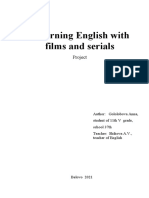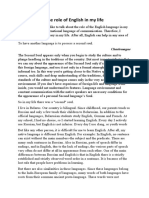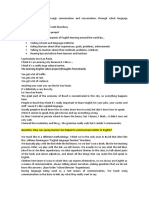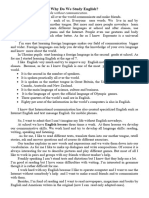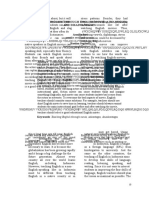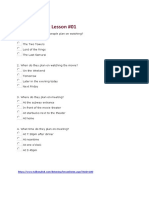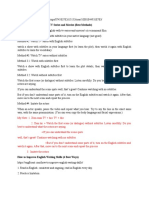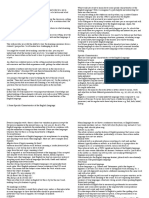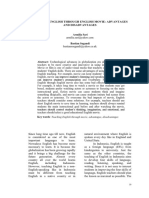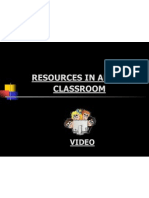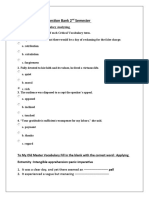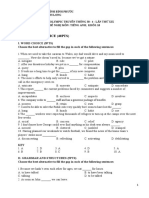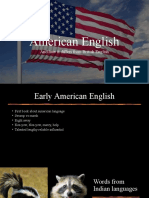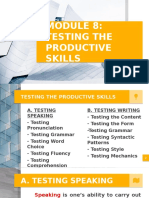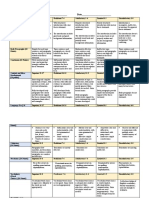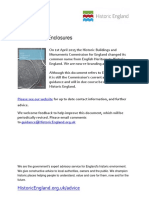Transcript - “Listening Time” Episode 169
Welcome to the Listening Time podcast. Hey everybody, this is Conner, and
you're listening to Episode 169 of the Listening Time Podcast. I hope you're doing well,
and I hope that these episodes have been useful for you. I hope that you like this
content that I give you.
And speaking of content, we're going to talk today about my favorite language
learning content. And speci cally, I'm going to talk about content for your input,
meaning what you listen to and read. So, I'm going to talk about what I prefer, in terms
of language learning content. And I hope that this will help you when you choose what
content to use when learning English, or any other language.
But rst, I'm going to talk about what I don't like to use, what content I don't
prefer as a language learner, just so I can help you understand my reasoning, so you
can see why I prefer certain content, and not other content. And I hope this analysis
will help you make your decision about what content you want to use for your language
learning. So, this is a very relevant topic for all of us. I'm sure you'll enjoy it.
And if you need my help to understand native speakers when they speak fast,
then I encourage you to sign up for my membership, so you can get my specialized
listening training. You’ll get my Listening Practice Seminars, in which I help you identify
the di erent di cult sound patterns in English. And if you become a Listening Time
Family Member, you'll get my advanced podcast episodes in which I speak fast. So,
that's the practice that you need if you want to take your listening to the next level.
And of course, there's also my US Conversations Podcast, which you can use if
you want to practice listening to conversations between two native speakers. And we
talk about a lot of interesting topics. We talk about di erent places in the US, because I
talk to di erent English speakers from around the country. And I provide the transcript
with the de nitions of key words and phrases that we use. So, it's the perfect content
to help you practice with listening to more than one person talking. So, the link to sign
up is down below. And you have the transcript for this episode down below as well.
Alright, let's get started.
Okay, let's rst talk about the content that I don't like to use for language
learning. So rst, let me talk about movies. I know that many of you are interested in
using movies to learn English. I'm sure that most of you like watching movies in your
free time, in your own language. And I know that many of you will disagree with me
about this, and that's perfectly ne. I'm just talking about my personal preferences, and
I'll give you the reasons why I don't like certain things and why I do like certain things.
So, why don't I use movies for language learning? Well, rst of all, this is really
important to remember, that movies are scripted, meaning someone writes a script,
and then the actors memorize the lines, and then they say them. And so, this is not
natural speech. Okay? Even if the actors are really good, it doesn't matter. That's
irrelevant, because what I'm talking about here is the actual writing of the script. If you
write a script, then you are not producing natural speech. Okay? I know this, because
I've made a lot of content, where I had a script that I read from, and it is very obvious
that that isn't natural speech.
So, when someone writes a script for a movie, they don't include all of the
boring or redundant things people say, like the word “right” and the word “like” and the
ff
ff
fi
fi
fi
ffi
fi
fi
fi
ff
fi
� word “so.” You don't hear those words as much in movies, because, of course, the
person writing the script doesn't want to put those basic words in there that people
use in real life, when they're trying to think of what to say next. Of course, we don't
want to hear that in movies. We don't want to hear the person saying “uh” in between
their di erent lines that they say, right?
So, these scripts that are written for movies are not natural speech, and they
don't include all of the normal, boring things that people talk about. And everything in
that script is in there for a reason, and that's not how we speak in real life. We say tons
of things that don't really have a purpose, but we just say them, and they're part of our
speaking style. And so, movies don't have natural speech.
And remember that there's a very limited amount of time for these movies, so of
course, they're just trying to t the most interesting dialogue in there as possible. And
that's just simply not normal. Right? When you hear a native speaker talking, they're
going to waste a lot of time, so to say, saying things that aren't necessary, repeating
words, repeating phrases.
And this is another reason why I don't use movies, is because of the lack of
repetition. Because the speakers in the movie aren't repeating their words a lot,
repeating their phrases, and using the same phrases over and over again. But in reality,
native speakers do this. Okay? And the other reason why there isn't a lot of repetition,
in terms of just using movies, in general, for language learning, is that when the movie
ends, now, when you go to watch another movie, it's a completely di erent story, and
the actors are di erent, and they're saying completely di erent things.
So, it's not like when you watch di erent videos from a YouTube channel, where
the same person is talking in di erent videos, and you get to hear them talk again and
again, about di erent topics, and you hear them use their same words, their same
phrases that they tend to use. You don't get that in movies.
So, because you don't get this repetition, you don't learn new words and
phrases as easily, in my opinion, because you don't hear them repeated as much. You
hear completely di erent words. You hear completely di erent speaking styles in every
single movie. So, I like continuity. I like repetition, so that I can learn new words and
phrases more easily. And that's something that I don't get with movies. So, that's
another reason why I don't like them.
And I don't like all the distractions, because it's not all focused on what people
are saying… in the movies. There are special e ects and music, and there are periods
when no one is talking. And I want to maximize my time as a language learner. If I have
one hour to practice my listening, I want to be listening to English, and only listening to
a person talking for that whole hour. I don't want all the other distractions, and I don't
want to waste any of those minutes listening to something or watching something that
isn't just the person speaking the language that I'm learning, right? So, those are some
reasons why I don't use movies for language learning. And I don't even watch movies
in English. So, that's another reason why I don't use movies.
And I also don't use TV shows, TV series. I think that they're better than movies
in terms of language learning content, because there's more continuity. You get to see
the same characters in multiple episodes, and you hear them speak a lot more about
di erent things. And so, there's the possibility for more repetition, and you can get
ff
ff
ff
ff
ff
fi
ff
ff
ff
ff
ff
ff
� more accustomed to their speaking style, and you can become more engaged. And I
think that using TV shows is probably better than using movies.
But it's still not natural speech. Right? It's still scripted. This isn't how people
actually talk in real life. That's the big issue with this. So, because of that, I don't use
TV shows either. And TV shows still have all the same distractions that movies have.
It's not just about the dialogue. There are a lot of periods where you're watching a
scene where no one is talking. Or there's a dramatic car chase. And really, the focus is
on the action, and not the words, and there's distracting sound e ects and music, and
all of that. So, because the language isn't 100% the focus the whole time, I don't want
to use TV shows either.
But mostly, it's because of the unnatural speech. I don't want to use scripted
movies or TV shows if I'm trying to listen to native content, right? Of course, scripted
content can be good if you're at a lower level, and you need scripted content, but I
wouldn't use movies or TV shows for that, if I'm a very beginner. Because for me, that
seems way too hard. I'm probably going to use scripted content that's made for
learners of that language, right?
So, another thing that I don't like to use for language learning is YouTube videos
that are heavily edited. What I mean by this is, if the YouTube videos have a lot of cuts,
and they go super fast, and there are a lot of dramatic elements in the editing. And
most YouTube videos that are popular have some of this, honestly, because these are
the YouTube videos that tend to capture people's attention, right? People edit their
videos like this, so that they can capture your attention and you don't get distracted or
bored. That's why you see videos edited like this.
However, because they're edited like this, they're unnatural. The speech is
unnatural. Everything is super fast. There are tons of distractions. And it's not
authentic. They don't leave in all the ller words like I mentioned before, like “right” and
“so.” And they don't have as much repetition, usually, because they're more scripted,
so they don't want to include boring, repetitive things in those videos. And in general,
they're just not natural, and they're harder to use. So, I don't use YouTube videos that
are heavily edited in a dramatic way like that. If I see that the video is like that, I click
out, and I nd another video.
And one other thing that I don't use is children's books. So, some people like
children's books for language learning, because they think that these books were
written for children, so they should be good for language learners. But these books
include a lot of language, a lot of words, that are not common, because a lot of these
books are about animals and fantastic things… not things that adults would normally
read about or talk about.
I know this, because my son loves books. And my wife and I read him a lot of
books, and there are many times when we're reading a book in English, and my wife
has no idea what some of the words mean on that page, because they're not words
that adults would normally use in normal conversations. For example, they might be
words describing the intricate movements of a certain animal, or something. And, yeah,
it's cool to learn those words, but you're probably never going to hear those words in
your everyday life.
And another reason why I don't like children's books for language learning is
that they're not that interesting for adults. And, in my opinion, it's best to use content
fi
fi
ff
� that you're interested in. This will help you actually learn more of the language. So,
because of that, I don't use children's books.
Okay, I talked all this time about what I don't like to use. Now, let me talk about
what I do like to use for language learning. First of all, I love using YouTube videos that
aren't heavily edited… in other words, YouTube videos that don't have a bunch of
distractions. I like to use videos where it's a person talking to the camera, just a person
talking to the camera, and not heavily edited, not too many cuts, for example.
And I like when they allow for authenticity, when they have some boring
repetition or redundant words that they keep using again and again, and they're kind of
improvising as they're speaking. They keep all of those elements in there, that heavily
edited videos don't have. So in other words, I love using YouTube videos that are very
authentic, where it sounds like someone just turned the camera on and started talking.
I like that.
And I like using many videos from the same channel, from the same YouTuber.
So, I nd a channel and I watch a bunch of their videos, and I hear them repeat many
words and phrases that they have the tendency to use, and this allows me to learn a lot
of vocabulary in a natural way. And of course, I nd YouTube channels about content
that I'm really interested in, right, subjects that are really interesting for me.
And I tend to use YouTube videos for my active listening practice, meaning when
I'm just there with the computer or my phone, and I am watching it. I'm looking at the
screen. I'm listening. And I can activate the subtitles if I want. So, in other words, my
full attention is on this video. So, I really like using YouTube videos for active listening
practice. It's very engaging for me to do that. I like this content overall.
And then I also really like podcasts. Podcasts are fantastic for language learning,
because they don't have all the same editing that many YouTube videos have. So,
because of their format, they don't have all these same distractions. And usually,
podcasts have a much more natural speech than the average YouTube video. Because
podcasts are usually meant to be authentic, natural, improvised, where the person is
just talking normally. And that's the best thing for language learning content.
So, I love podcasts. I listen to tons of di erent podcast episodes in French, for
example. And I really like using podcasts for my passive listening practice, when I'm
not just sitting down, focused on the actual material. I like using podcasts when I'm
walking, or running, or working out, for example. I will listen while I'm doing these other
things. So, my attention is not 100% on the content, because sometimes I have to
focus on something else in the physical world, right? But I'm still pretty focused on the
content.
And I also like this for passive listening because I don't have the subtitles,
usually. It’s just a podcast, right? And so, because of that, I don't really have the same
ability, like with YouTube videos, where I can just activate the subtitles, and use that
more e ectively for my active listening practice. I can't do that with podcasts. They
don't have that feature, usually. So, it's good to just use these while I'm doing
something else, and I can just listen passively and get that extra practice in.
So, for this podcast, my podcast, that you use, you actually have the transcript,
so you can use this more e ectively for your active listening practice, if you'd like. But
you can also use it for passive listening. You can listen to this while you're driving while
fi
ff
ff
ff
fi
�you're doing the dishes, etc. Right? So, podcasts and YouTube videos that are natural,
that aren't heavily edited, these are my main two types of content that I use.
And one other type of content that I like, and that I recommend, is reading
material that is relevant or interesting to me. Okay? So, not children's books, not just
whatever book someone recommends you… I think that it's best to use material that's
actually interesting for you up. And, for example, I always talk about the website, lingq,
l-i-n-g-q, this is a perfect way to read things that are interesting for you, because you
can input your own text, like the text from your Kindle book or whatever, and then it
generates an automatic translator for you. So, you can click on any word and see the
translation.
So, because of this type of tool, you can just read whatever you want to read,
whatever is interesting for you. And so, when people ask me to recommend them
books to read in English, I always just tell them, read what you want to read. Read
what you would normally like to read in your own language, but use this tool. Use lingq
or something similar, right? And I think that that's the best thing to do.
And it might be hard for you to read full books, depending on your level. But
what you could read is online articles, read articles that are about subjects that you
like, and use that type of tool that I mentioned, so that you can do this more easily. So,
this is the third type of material that I use. I use reading material, like books or articles
that are interesting for me, that are about a topic that is relevant to me, or something
that I want to learn about, or whatever. So, that's what I use.
So hopefully, this helps you maybe analyze what type of content you should be
using for your language learning. And if you disagree with me about some of these
things, like if you really like movies and want to use movies, then that's perfectly ne.
I'm just talking about my preferences. And I'm trying to help you out if you really don't
have a preference, if you don't know what to use. Hopefully, this will be kind of like a
guide for you. But if you already know what you like to use, then go ahead and use that
type of content.
And one type of content that will de nitely be helpful for you is my advanced
podcast episodes, in which I speak at normal speed, and I provide the transcript. So,
make sure to sign up for those by becoming a Listening Time Family Member. The link
is down below.
And another type of content that can be very helpful for you is my US
Conversations Podcast. So, the link to that is down below as well. Use that to practice
listening to two people talking instead of just one. This US Conversations Podcast is a
great introduction to that type of content. Okay? Alright, thank you for listening to this
episode, and I'll talk to you on the next episode of Listening Time.
*Get my training and advanced episodes: www.patreon.com/listeningtime
*US Conversations Podcast: www.patreon.com/USConversations
fi
fi
